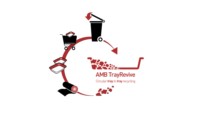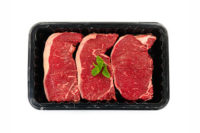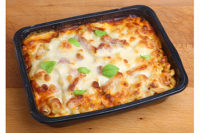If you hosted or attended any holiday gatherings as 2016 came to a close, chances are good you enjoyed the ultimate convenience: a ready-to-serve party tray.
The party tray concept is more convenient than ever. Although you can still order a party tray from your favorite grocery or deli and many restaurants, grab-and-go options are proliferating. For example, Hormel Foods, based in Austin, Minn., now offers nearly a dozen stock-keeping units in its Gatherings brand. Three relatively recent additions to the Gatherings line, Culinary Pairings, combine dried fruit, nuts and cheese with slices of Italian dry salami, sopressata or hot sopressata. The rest of the Gatherings lineup consists of two party trays with two meats and two cheeses plus crackers, a larger Supreme Party Tray and five smaller snack trays. When the party starts, each rectangular tray doubles as a serving platter.
A circular two-piece tray holds a ring of party-ready shrimp, distributed by Beaver Street Fisheries, Inc., in Jacksonville, Fla., and sold by Walmart, based in Bentonville, Ark. Sold frozen, the package is placed in the refrigerator to thaw overnight. Right before serving, the host removes a paperboard band and clear domed lid and then peels away the clear film covering the shrimp and the clear lidstock sealing a small tub of cocktail sauce, which rests in the center of the ring. For spur-of-the-moment gatherings, the lidstock and film are left in place, and cold water is run over the shrimp and the cocktail sauce tub to quickly thaw the two for serving.
Another tray packaging segment showing growth is vacuum skin packaging. A report published by Technavio, Elmhurst, Ill., in 2016, “Shift to Vacuum Skin Packaging Will Boost Revenues in Global Skin Packaging Market by 2020,” projects a 5 percent compound annual growth rate through 2020.
Although used for other types of food and nonfood products, vacuum skin packaging is particularly popular for meat, poultry and seafood products. For example, a U.K.-based mail-order supplier of venison products, Holme Farmed Venison, uses it to protect its frozen products. Vacuum skin packaging helps lock in flavor and juices and extend shelf life as much as 30 percent versus conventional modified-atmosphere packaging. It also eliminates product discoloration and leaks for improved store presentation and enhanced food safety, imparts tamper evidence and can be coupled with easy-opening devices. Resulting packages are freezer-ready and provide high product visibility.
Meanwhile materials and tray-sealing equipment continue to evolve. On the materials side, a laminated, moisture-resistant paperboard tray offers a renewable alternative to plastic. The recyclable paperboard not only extends meat, poultry or seafood shelf life, but also boosts shelf impact. It is compatible with vacuum skin technology and easy-opening features and results in a leak-proof package. Because top and bottom surfaces can be printed, there’s no need for a label. As a result, packaging material costs drop and packaging line productivity increases.
Tray sealers come in automatic and semiautomatic models and inline or standalone configurations. Many accommodate two, three, four or more lanes and modified atmosphere packaging (MAP). Typical attributes include hygienic design, compact footprint, easy operation via a touch screen, speeds up to 150 trays per minute and compatibility with easy-opening and resealing features. Some vacuum skin packaging equipment applies lidstock without generating any scrap, which must be recycled or landfilled.
Seal quality is assured by continual monitoring of heat, pressure and dwell time. Quick, toolless changeover reduces changeover time to a range of five to 10 minutes. On one model, an onboard carrousel shortens changeover time by holding tooling for up to four formats. When it’s time to make a change, the next tool can be preheated to further shorten downtime. Changeover tooling also may be stored on wheeled carts.
Common options include date coders, labelers, online gas analyzers for MAP, tray denesters, portioning equipment, automatic tray loaders and extended product loading areas.
Instead of flat lidstock some tray sealers can accommodate a dome or lidstock equipped with a valve. A domed lid makes it possible to package a product that extends above the flange of the container in a shelf-life-extending modified atmosphere. The valve permits in-pack cooking or steam heating. Another option is multi-compartment trays which allow product from one compartment to be used while the rest of the package remains completely sealed to maintain any modified atmosphere and product shelf life. NP




Report Abusive Comment